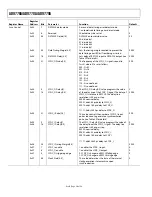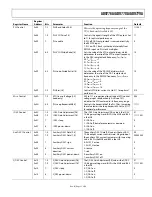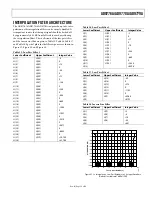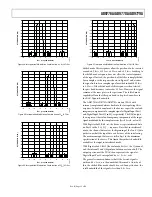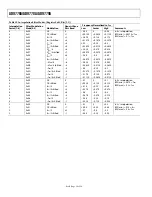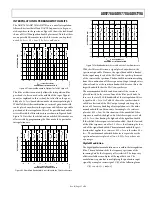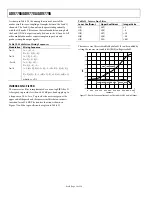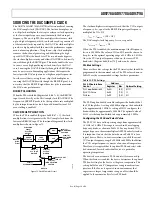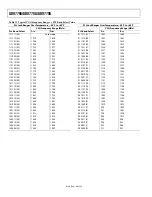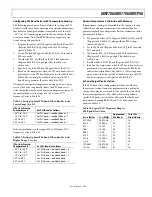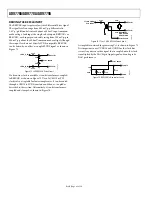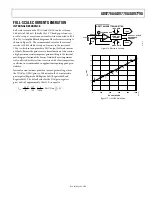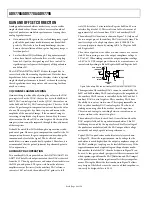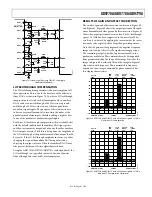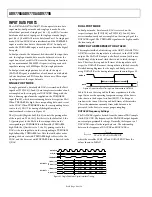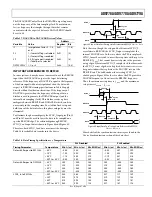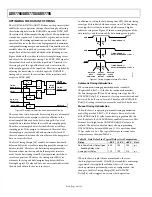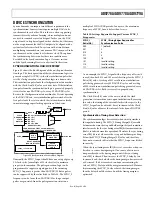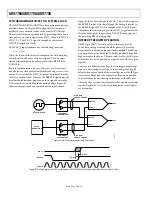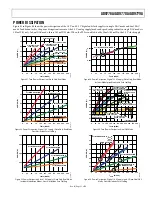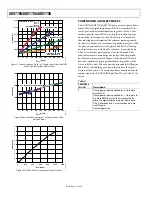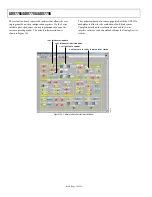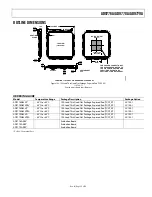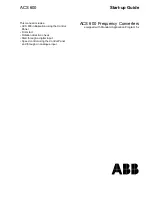
AD9776A/AD9778A/AD9779A
Rev. B | Page 44 of 56
GAIN AND OFFSET CORRECTION
Analog quadrature modulators make it very easy to realize
single sideband radios. However, there are several nonideal
aspects of quadrature modulator performance. Among these
analog degradations are
•
Gain mismatch: The gain in the real and imaginary signal
paths of the quadrature modulator may not be matched
perfectly. This leads to less than optimal image rejection
because the cancellation of the negative frequency image is
less than perfect.
•
Local oscillator (LO) feedthrough: The quadrature mod-
ulator has a finite dc-referred offset, as well as coupling
from its LO port to the signal inputs. These can lead to
significant spectral spurs at the frequency of the quadrature
modulator LO.
The AD9776A/AD9778A/AD9779A have the capability to
correct for both of these analog degradations. Note that these
degradations drift over temperature; therefore, if close to optimal
single sideband performance is desired, a scheme for sensing
these degradations over temperature and correcting for them
may be necessary.
I/Q CHANNEL GAIN MATCHING
Gain matching is achieved by adjusting the values in the DAC
gain registers. For the I DAC, these values are in the 0x0B and
0x0C I DAC control registers. For the Q DAC, these values are
in the 0x0F and 0x10 Q DAC control registers. These are 10-bit
values. To perform gain compensation, raise or lower the value
of one of these registers by a fixed step size and measure the
amplitude of the unwanted image. If the unwanted image is
increasing in amplitude, stop the procedure and try the same
adjustment on the other DAC control register. Do this until the
image rejection cannot be improved through further adjustment
of these registers.
It should be noted that LO feedthrough compensation is inde-
pendent of gain. However, gain compensation can affect the LO
compensation because the gain compensation may change the
common-mode level of the signal. The dc offset of some
modulators is common-mode level dependent. Therefore, it is
recommended that the gain adjustment be performed prior to
LO compensation.
AUXILIARY DAC OPERATION
Two auxiliary DACs are provided on the AD9776A/AD9778A/
AD9779A. The full-scale output current on these DACs is derived
from the 1.2 V band gap reference and external resistor between
the I120 pin and ground. The gain scale from the reference
amplifier current (I
REFERENCE
) to the auxiliary DAC reference
current is 16.67 mA with the auxiliary DAC gain set to full
scale (10-bit values, 3-wire interface Register 0x0D and 3-wire
interface Register 0x11). This results in a full-scale current of
approximately 2 mA for auxiliary DAC1 and auxiliary DAC2.
The auxiliary DAC structure is shown in Figure 78. Only one of
the two output pins of the auxiliary DAC is active at a time. The
inactive side goes to a high impedance state (>100 kΩ). The
active output pin is chosen by writing to Bit 7 of Register 0x0E
and Register 0x12.
The active output can act as either a current source or a current
sink. When sourcing current, the output compliance voltage is
0 V to 1.6 V. When sinking current, the output compliance voltage
is 0.8 V to 1.6 V. The output pin is chosen to be a current source or
current sink by writing to Bit 6 of Register 0x0E and Register 0x12.
0
645
2-
3
03
AUXP
AUXN
P/N
SOURCE/
SINC
0mA TO 2mA
(SOURCE)
V
BIAS
0mA TO 2mA
(SINK)
Figure 78. Auxiliary DAC Source/Sink for AD9776A/AD9778A/AD97779A
The magnitude of the auxiliary DAC1 current is controlled by the
0x0D and 0x0E auxiliary DAC1 control registers; the magnitude of
the auxiliary DAC2 current is controlled by the 0x11 and 0x12
auxiliary DAC2 control registers. These auxiliary DACs have
the ability to source or sink current. This is programmable via
Bit 6 in either auxiliary DAC control register. The choice of
sinking or sourcing should be made at circuit design time.
There is no advantage to switching between current source or
current sink once the circuit is in place.
The auxiliary DACs can be used for LO cancellation when the
DAC output is followed by a quadrature modulator. This LO
feedthrough is caused by the input-referred dc offset voltage of
the quadrature modulator (and the DAC output offset voltage
mismatch) and may degrade system performance.
Typical DAC-to-quadrature modulator interfaces are shown
in Figure 79. Often, the input common-mode voltage for the
modulator is much higher than the output compliance range of
the DAC, making ac coupling or a dc level shift necessary. If the
required common-mode input voltage on the quadrature modu-
lator matches that of the DAC, then the dc shown in Figure 79 can
be used. A low-pass or band-pass passive filter is recommended
when spurious signals from the DAC (distortion and DAC images)
at the quadrature modulator inputs may affect the system perfor-
mance. Placing the filter at the location shown in Figure 79 allows
easy design of the filter because the source and load impedances
can easily be designed close to 50 Ω.

